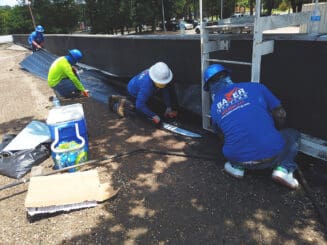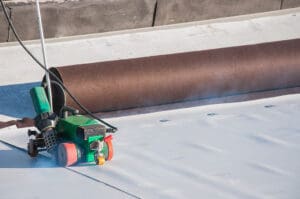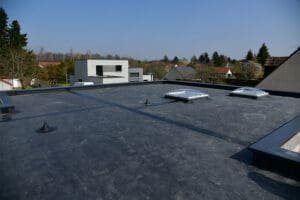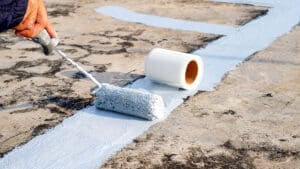
A Flat Roof Guide for Commercial Building Owners and Property Managers
When you are a commercial building owner or a property manager, being committed to a budget is essential to making a profit. One of the most critical components of your building is the roof system. This commercial roof guide helps you to understand the ins and outs of flat roof repairs, replacement, and maintenance.
Budgeting for preventative maintenance, repairs, and eventual replacement of your roof will help you maintain a successful budget.
Preventative Maintenance Program for Commercial Roofs
A Preventive Maintenance Program (PMP) will ensure your roof is in its best condition for its entire lifespan. Implementing a PMP will keep your roof clean and free of harmful debris, ensure that it is properly sealed and that minor repairs are completed before they can become significant issues.
Additionally, a PMP will provide you with a timeline of the life of your roof, allowing you to plan and budget for its replacement. The roofing company providing you with the PMP can help you save money by limiting the number of major repairs and water damage that results from roof issues. They will also tell you when the repairs will cost you more in the coming years than a replacement would cost.
Repairs
Flat roofs are designed so that minor repairs can be performed at a minimum cost. Waterproof membranes get small pinhole punctures, tears, and perforated seams. All of these types of repairs are quickly repaired. However, repairs will be needed more frequently as the membrane ages, and the cost will also increase. At this time, it is wise to consider a new roof covering.
Commercial Flat Roof Systems
BUR Roof System
Built-up roof systems are roofs primarily comprised of a three-piece system, bitumen, ply sheets, and a top layer. Insulation board can also be incorporated as a fourth component of the BUR system.
If an insulation board is used, it will be installed first and then layered with bitumen, which can either be cold or hot-applied and ply sheets. After several layers have been applied, a top layer of a specialized ply sheet or a stone or gravel ballast finishes it off.
BUR roof systems have been around for many years and are one of the oldest flat roof systems.
TPO
TPO is thermoplastic polyolefin, a single-ply waterproof membrane that began being installed in the US on flat roofs in the 1990s. An insulation board is installed before the TPO membrane, and TPO can be installed fully adhered with an adhesive or installed mechanically with plates and screws, and then the seams are hot-air welded.
TPO waterproof membranes can last up to 30 years if well maintained with a proper preventative maintenance program, but other components will fail. Seams will need to be re-welded, and flashings will need to be re-sealed.

EPDM
EPDM (ethylene propylene diene monomer) is a synthetic rubber single-ply waterproof membrane. While similar to TPO, it has a much different chemical makeup, and it is a durable, tear-resistant material.
EPDM is very versatile and can be used in various roofing situations, including under solar panels, and green roofs, and it can even be used in water features as a liner.
EPDM does have its issues. As EDPM ages, it may be susceptible to shrinkage, cracking, and eventual tears. Additionally, it does not have the best heat reflection as some other roof coverings like TPO.

Modified Bitumen
Modified bitumen is a roofing system comprised of two components, base sheets, and cap sheets. The roofing material is applied in two ways either torch down or self-adhered. The most common and acceptable application for commercial flat roofs is applied with heat, and a roofing torch is used to heat the bitumen that is attached to the ply material. The ply is rolled out as it is being heated, and it seals to the roof deck. Depending on the roof specs, Multiple base layers can be installed on top of each other, but only one base sheet is the most common system.
A cap sheet is applied the same way as the base sheets; the difference is that the cap sheet is granulated on top to add to the protection of the ply. Cap sheets come in several different colors, some of which are considered cool roofs which are better with heat transmissivity.
Self-adhered base and cap sheets are precisely as they sound. They have adhesive on the back and stick down to the roof deck. Self-adhered sheets are more often used on small projects or in residential roof systems.
Liquid Applied Roof Membrane
Liquid-applied roof membranes, or roof coatings, are waterproof roof coverings that are sprayed or rolled on the entire roof. Liquid-applied roof membranes are one continuous membrane, so there are no seams that can leak or come unsealed. The membrane can be rolled on at different rates, which will affect the thickness and protection it will provide.
Liquid-applied roofing membranes are available in different chemical makeups. Acrylic, urethane, silicone, and fluoropolymers are all standard liquid membranes. Each type has its benefits and features that make them good choices.

Metal Roof
Metal roofing is an attractive choice to make a statement on flat roofs. When metal roofing, like standing seam, is installed on a flat roof, a specialized ice and water barrier must be used to ensure a tight water seal. The seams on the standing seam roof need to be mechanically fastened, which means that a machine bends the two panels together and crimps them together.
Walk Pads
Also, don’t forget about walk pads. Walk pads are a very important part of the roofing system for materials like TPO and EPDM. Walk pads add protection to keep the membrane from wearing out due to foot traffic and help resist punctures.
Back to Blog
